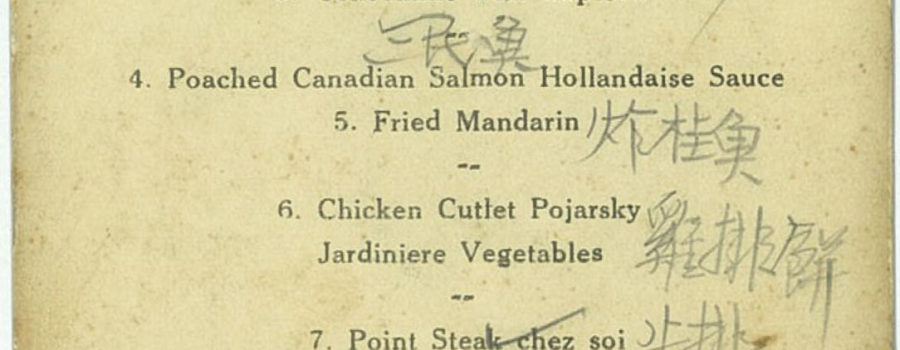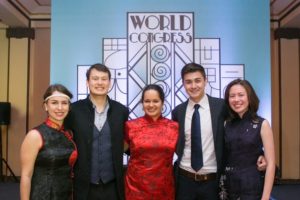When the Art Deco Cathay Hotel opened in 1929, became the place to go for dancing, drinking, and of course, dining. So naturally, when we hosted the World Congress on Art Deco in Shanghai in 2015, we selected one of the legendary hotel’s vintage menus for our Gala evening.
Today, the Cathay is the Fairmont Peace Hotel, and their archive of menus is an extraordinary insight into both culinary history and Shanghai’s history. We perused dinner menus, tea menus, bar snack menus, and café menus. Menus with hugely inflated prices during the Nationalist-era hyperinflation, Christmas menus, menus entirely in French, even diet menus. It is a history of Shanghai, told through menus.
1932 Menu
The Gala Menu was based on a menu from 1931, priced at “$6”. That’s six Mexican dollars. Wait, what? Mexican dollars? Yes: many people preferred using the trusted Mexican silver dollar to carrying strings of traditional Chinese coins (“cash”), so the currency in circulation in international Shanghai at the time was “dollars Mex”.
The dishes on our menu reflect the city’s cosmopolitan roots: Chicken Pojarsky is named for the favorite chef of Tsar Nicholas I. Most likely it had made its way to Shanghai via the White Russians who had flooded into the city in the wake of the Bolshevik Revolution. The Tsar enjoyed this dish, which features breaded ground chicken, served with paprika cream.
Point Steak refers to the French term, à point, which in the French kitchen means “perfectly cooked” — rare to medium rare. Diners are not asked how they would like their steaks – instead, it is served à point – perfectly cooked. Yes, the Cathay was so chic that the French even ventured out of their Concession to dine here!
Nesselrode Pudding is a Victorian ice pudding, flavored with chestnuts and maraschino. Created in 1814 by French chef de cuisine Marie Antoine Carême–known as the king of chefs and chef of kings–for diplomat Count Karl von Nesselrode. The pudding was extremely popular in the 19th century, especially with the English upper classes, and was no doubt a favorite of some of the crusty British members of the tony Shanghai Club, who just had to toddle a few blocks down the Bund from their clubhouse at No. 2 to sample the fare.
The names of the dishes on these menus are just delightful: Mangatsuwo Meuniere; Shell of Poultry Florentine, Timbale Macaroni Financier, Chicken Sante Marengo. Anna Potatoes, Fillet Steak Klavdia, Chicken Casanova.
Eating was a very, very serious affair, and it wasn’t just dinner. Luncheon was an occasion: a menu from 1931 offers 40 courses and coffee, including a joint wagon, oxtail curry and rice (prepared by a Madras chef), grill, cold buffet, sweets, cheese, and more.
The Flapper Diet
All those delicious dishes and extensive menus may perhaps be why the Cathay also had a series of menus from 1936 and 1937 labelled “Hay Dieting”. Divided into starches and proteins, the menus nonetheless feature some decidedly un-diet-like dishes, such as butter and baked potato, caramel rice pudding, sour cream waffles with maple syrup – but they also include brown rice, whole wheat bread and raw vegetables.

Flappers swore by the Hay Diet for acquiring the thin arms needed to look good in the dresses of the era. Heiress Oei Hui-lan had the classic flapper look.
It turns out that the Hay Diet was the trendy diet of the period. Also known as the “Flapper Diet”, it was created by a New York based physician, and enthusiastically embraced by women who desired the stick-thin arms and legs required to achieve the proper flapper look. The premise was that food should be separated into proteins and starches, acids and alkalines – and apparently it is making a comeback!
Thousand Dollar Dining

This menu features “Borscht”, the Russian soup that is now a part of local Shanghai cuisine as “luo song tang” (“Russian soup”).
The Japanese occupation of international Shanghai began in December 1941, and the 1943 menus show increased prices – individual dishes were priced at up to $75, compared to an entire menu for $6 a decade previously. But that was nothing compared to what was to come.
Postwar Shanghai saw the Nationalist government back in charge, printing money, even as the population was losing faith in the China National Currency. The resulting hyperinflation was reflected in the menus: by 1945, “special coffee” was $100 Chinese yuan and a sandwich would run you $180.
In 1946, a set menu would run you CNC$840; by 1948, it was $380,000. This was the era when money had to be carted around in wheelbarrows because people needed so much to buy everyday things. Isiah Zimmerman, who grew up in Shanghai, remembers running to the shops as soon as he got paid – because the prices would go up, up, up, if you waited even a few minutes.
In March 1949, just two months before the Communists would march past the Cathay as they took the Bund and Shanghai, a hot dog cost $2800. It’s almost poignant that these indulgent treats like potato chips and ice cream sodas were still being served as old Shanghai was disintegrating.
Happily, our menus for the Gala were priced much more reasonably — RMB 640 for an evening at the Cathay!










Most Commented Posts